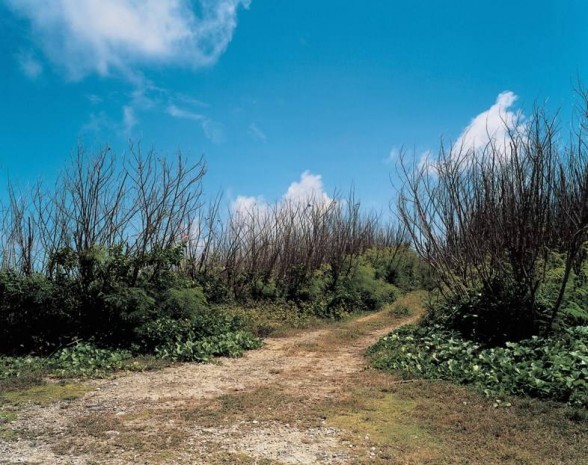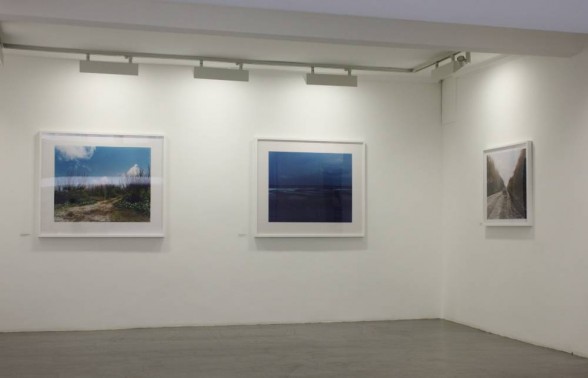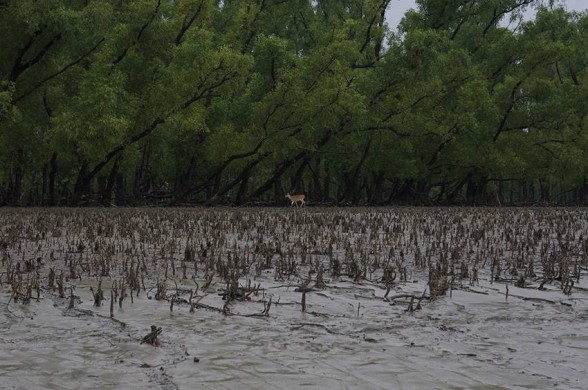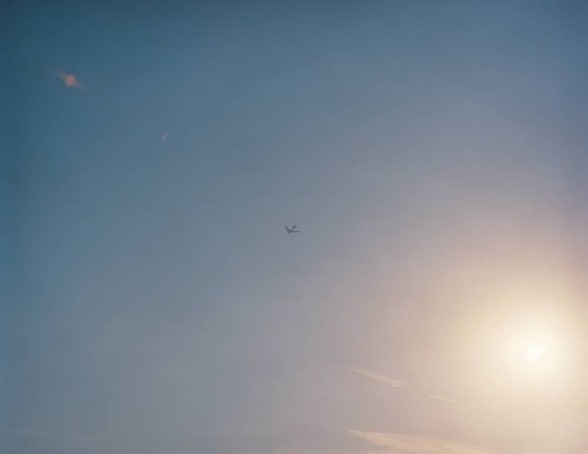[Our U.K. correspondent, Katie, visits a show demonstrating how knowledge of history can change our perception of an image or imbue it with meaning. — the Artblog editors]
Gazing at a photograph in Tomoko Yoneda’s Beyond Memory at the Grimaldi Gavin in Piccadilly, what I see is a beautifully composed, though desolate, image. A rough dirt path reaches up through sharply-defined undergrowth and bare black twigs to a singing sapphire sky, a sparse scene with a delicious stillness to it. But after a glance at the caption, the scene is irrevocably changed; the short note tells me that what I am looking at is the path to the cliff where Japanese went to commit suicide after the American landing in WWII. Looking back at the photograph, the pain and desperation of that moment now pops from every shadow, the twists of the dark reaching branches suddenly charged with the enormity of what once occurred there.
Early journalistic interest

The photographs range across the clean walls of the Grimaldi Gavin basement gallery, each section featuring a selection from some of Yoneda’s best-known series. Yoneda has been represented by the gallery since June 2014, and this first exhibition of her work echoes the major retrospective of her work at the Tokyo Metropolitan Museum of Photography in 2013, encompassing highlights from a body of work that tackles wars, great disasters, and the big events of history.
Her work has reflected a very international life. Born in Japan, she went on to study both in the U.S.A. and in the U.K., where she now resides. She focuses on large-scale events with international implications, from World Wars to the issues facing her country of birth; exhibitions this year in Boston and Hyogo have featured work that she made in response to the Great East Japan Earthquake of 2011 and Kobe Earthquake in 1995, respectively. Her work also reflects an early interest in journalism, but, overtaken by her father’s passion as an amateur photographer, Yoneda describes a moment when she “realized that I could communicate just as much through images as through words”. This passion for telling true stories is surely evident in the subjects she chooses.

Significance in silence
Words and images work in combination in journalism, just as in much of our printed communication. The exploding “POW!” underlines the violence of the comic book hero’s punch; a woman’s plastic smile illustrates the satisfaction promised by the brand name emblazoned below her image. We’re well accustomed to using the newspaper caption to bring out the thrust of a grainy, printed image, fixing the shot of a particular building on a particular street as the site of an important event, a political agreement, a murder.
The presentation of Yoneda’s haunting photographs takes that same label/image format, but the difference is that in these photographs it is the absence, the lack of action, that those captions bring to the fore. A photograph depicting a calm woodland is captioned as the location of the battle of the Somme, but the absence of any tangible trace of the violent past creates a surprising disjunction. The image shows nature at work, delicately photographed, moving on indifferent to the horror that the viewer’s mind now inevitably recreates.
In an interview for the Asia Art Archive, Yoneda talks about the interface between history and physical spaces. “History is not only apparent in tangible monuments or buildings, but also expresses itself impassively in various intangible ways […] its shadow communicates itself with the awareness stored within our experiences, entering into the depths of our vision and dwelling in our daily lives,” she said.
This last comment is interesting. The scope of Yoneda’s subject matter is broad, the events that she refers to ranging from the time of WWI to the current effects of climate change. As each caption offers little more than a name or the briefest description of an event, the knowledge that a viewer brings with them is integral to their understanding of the significance of a photograph; though all of the information is there in the collective memory of human history, an individual may still only consciously access as much or as little as they are able to furnish from their own experience. Some of these photos are bound to remain hauntingly obscure, their devastating import something that remains unsettlingly close but that one can only guess at.

Links to the everyday
Yoneda carries out extensive research to find the locations described in each one of her photographs. Her precise attention to history calls to mind the work of Thomas Demand, the artist who carefully constructs paper models to exactly recreate photographs taken in the wake of dramatic events. But where Demand’s photographs echo the flashbulb of public documentation that settles on and immortalises a moment, Yoneda instead connects that event to a real place with its own life, which has not stopped, but moves with the passing of time.
One of the most affecting sets of images in the show takes a different slant–three photographs whose caption reads “American B-52 returning from a bombing raid on Iraq, Fairford, England, 2003”. The plane is distant, a hazy speck in the beautifully clear blue sky, and the contrasts are suddenly shockingly felt, between a calm summer’s day in a prosperous nation and that same nation’s violent involvement halfway across the world. The reminder this time is that that those great violences are also happening right now, if we only choose to see them.

It’s easy to lose the connection between catastrophic events and the mundane world of our everyday experience. We see images from warzones every day and recognise nothing in them, hear constantly about the effect that humans are having on our environment but struggle to feel the reality of those changes. Yoneda’s photographs draw jolting links between momentous events of politics and history and the very physical world in which they happen, and once she’s pointed to those lost connections, they are very difficult to forget.
Tomoko Yoneda’s Beyond Memory is on at Grimaldi Gavin, Piccadilly, until August 7, 2015.





